Italian fascism
| Part of a series on |
| Fascism |
|---|
 |
| History of Italy |
|---|
 |
|
|
Italian fascism (
Italian fascism originated from ideological combinations of
Italian fascism promoted a corporatist economic system, whereby employer and employee syndicates are linked together in associations to collectively represent the nation's economic producers and work alongside the state to set national economic policy.[3] This economic system intended to resolve class conflict through collaboration between the classes.[4]
Italian fascism opposed
Originally, many Italian fascists were opposed to
Principal beliefs
Nationalism
Italian fascism is based upon Italian nationalism and in particular seeks to complete what it considers as the incomplete project of
It identifies modern Italy as the heir to the
The Fascist state is a will to power and empire. The Roman tradition is here a powerful force. According to the Doctrine of Fascism, an empire is not only a territorial or military or mercantile concept, but a spiritual and moral one. One can think of an empire, that is, a nation, which directly or indirectly guides other nations, without the need to conquer a single square kilometre of territory.
— Benito Mussolini and Giovanni Gentile, The Doctrine of Fascism (1932)
Irredentism and expansionism
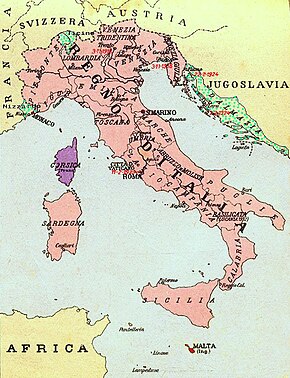
Fascism emphasized the need for the restoration of the
To the east of Italy, the fascists claimed that
To the west of Italy, the fascists claimed that the territories of
To the north of Italy, the fascist regime in the 1930s had designs on the largely Italian-populated region of
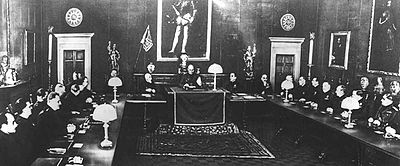
To the south, the regime claimed the archipelago of
To the south, the fascist regime held an interest in expanding Italy's African colonial possessions. In the 1920s, Italy regarded Portugal as a weak country that was unbecoming of a colonial power due to its weak hold on its colonies and mismanagement of them and as such Italy desired to annexe Portugal's colonies.[50] Italy's relations with Portugal were influenced by the rise to power of the authoritarian conservative nationalist regime of Salazar, which borrowed fascist methods, though Salazar upheld Portugal's traditional alliance with Britain.[50]
Racism
Until
In 1929, Mussolini acknowledged the contributions of Italian Jews to Italian society, despite their minority status, and believed that Jewish culture was Mediterranean, aligning with his early
Totalitarianism
In 1925, the PNF declared that Italy's fascist state would be totalitarian.[16] The term "totalitarian" had initially been used as a pejorative accusation by Italy's liberal opposition that denounced the fascist movement for seeking to create a total dictatorship.[16] However, the fascists responded by accepting that they were totalitarian, but presented totalitarianism from a positive viewpoint.[16] Mussolini described totalitarianism as seeking to forge an authoritarian national state that would be capable of completing Risorgimento of the Italia Irredenta, forge a powerful modern Italy and create a new kind of citizen – politically active fascist Italians.[16]
The Doctrine of Fascism (1932) described the nature of Italian fascism's totalitarianism, stating the following:
Fascism is for the only liberty which can be a serious thing, the liberty of the state and of the individual in the state. Therefore for the fascist, everything is in the state, and no human or spiritual thing exists, or has any sort of value, outside the state. In this sense fascism is totalitarian, and the fascist state which is the synthesis and unity of every value, interprets, develops and strengthens the entire life of the people.
— Benito Mussolini and Giovanni Gentile, The Doctrine of Fascism (1932)
American journalist
However, since World War II historians have noted that in Italy's colonies Italian fascism displayed extreme levels of violence. The deaths of one-tenth of the population of the Italian colony of Libya occurred during the fascist era, including from the use of gassings,
Corporatist economics
Italian fascism promoted a corporatist economic system. The economy involved employer and employee syndicates being linked together in corporative associations to collectively represent the nation's economic producers and work alongside the state to set national economic policy.[3] Mussolini declared such economics as a "Third Alternative" to capitalism and Marxism that Italian fascism regarded as "obsolete doctrines".[70] For instance, he said in 1935 that orthodox capitalism no longer existed in the country. Preliminary plans as of 1939 intended to divide the country into 22 corporations which would send representatives to Parliament from each industry.[71]
State permission was required for almost any business activity, such as expanding a factory, merging a business, or to fire or lay off an employee. All wages were set by the government, and a minimum wage was imposed in Italy. Restrictions on labor increased. While corporations still could earn profits,[71] Italian fascism supported criminalization of strikes by employees and lockouts by employers as illegal acts it deemed as prejudicial to the national community as a whole.[72]
Age and gender roles
The Italian fascists' political anthem was called Giovinezza (Youth).[73] Fascism identifies the physical age period of youth as a critical time for the moral development of people that will affect society.[74]
Italian fascism pursued what it called "moral hygiene" of youth, particularly regarding sexuality.[75] Fascist Italy promoted what it considered normal sexual behaviour in youth while denouncing what it considered deviant sexual behaviour.[75] It condemned pornography, most forms of birth control and contraceptive devices (with the exception of the condom), homosexuality and prostitution as deviant sexual behaviour.[75] Fascist Italy regarded the promotion of male sexual excitation before puberty as the cause of criminality amongst male youth.[75] Fascist Italy reflected the belief of most Italians that homosexuality was wrong. Instead of the traditional Catholic teaching that it was a sin, a new approach was taken, based on the contemporary psychoanalysis, that it was a social disease.[75] Fascist Italy pursued an aggressive campaign to reduce prostitution of young women.[75]
Mussolini perceived women's primary role to be childbearers while men were warriors, once saying that "war is to man what maternity is to the woman".
Tradition

Italian fascism believed that the success of Italian nationalism required a clear sense of a shared past amongst the Italian people along with a commitment to a modernized Italy.[9] In a famous speech in 1926, Mussolini called for fascist art that was "traditionalist and at the same time modern, that looks to the past and at the same time to the future".[9]
Traditional symbols of Roman civilization were utilized by the fascists, particularly the fasces that symbolized unity, authority and the exercise of power.[83] Other traditional symbols of ancient Rome used by the fascists included the she-wolf.[83] The fasces and the she-wolf symbolized the shared Roman heritage of all the regions that constituted the Italian nation.[83] In 1926, the fasces was adopted by the fascist government of Italy as a symbol of the state.[84] In that year, the fascist government attempted to have the Italian national flag redesigned to incorporate the fasces on it.[84] This attempt to incorporate the fasces on the flag was stopped by strong opposition to the proposal by Italian monarchists.[84] Afterwards, the fascist government in public ceremonies rose the national tricolour flag along with a fascist black flag.[85] Years later, and after Mussolini was forced from power by the King in 1943 only to be rescued by German forces, the Italian Social Republic founded by Mussolini and the fascists did incorporate the fasces on the state's war flag, which was a variant of the Italian tricolour national flag.
The issue of the rule of monarchy or republic in Italy was an issue that changed several times through the development of Italian fascism, as initially Italian fascism was
After being removed from office and placed under arrest by the King in 1943, with the Kingdom of Italy's new non-fascist government switching sides from the Axis to the Allies, Italian fascism returned to republicanism and condemnation of the monarchy.[90] On 18 September 1943, Mussolini made his first public address to the Italian people since his rescue from arrest by allied German forces, in which he commended the loyalty of Hitler as an ally while condemning King Victor Emmanuel III of the Kingdom of Italy for betraying Italian fascism.[90] On the topic of the monarchy removing him from power and dismantling the fascist regime, Mussolini stated: "It is not the regime that has betrayed the monarchy, it is the monarchy that has betrayed the regime" and that "When a monarchy fails in its duties, it loses every reason for being. ... The state we want to establish will be national and social in the highest sense of the word; that is, it will be fascist, thus returning to our origins".[90] The fascists at this point did not denounce the House of Savoy in the entirety of its history and credited Victor Emmanuel II for his rejection of "scornfully dishonourable pacts" and denounced Victor Emmanuel III for betraying Victor Emmanuel II by entering a dishonourable pact with the Allies.[91]
The relationship between Italian fascism and the Catholic Church was mixed, as originally the fascists were highly anti-clerical and hostile to Catholicism, though from the mid to late 1920s anti-clericalism lost ground in the movement as Mussolini in power sought to seek accord with the Church as the Church held major influence in Italian society with most Italians being Catholic.
Doctrine
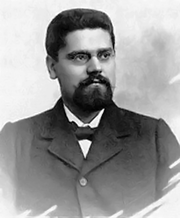
The Fascist accepts and loves life; he rejects and despises suicide as cowardly. Life as he understands it means duty, elevation, conquest; life must be lofty and full, it must be lived for oneself but above all for others, both near bye and far off, present and future.
In 1925, Mussolini assumed the title
Gentile defined fascism as an anti-intellectual doctrine,
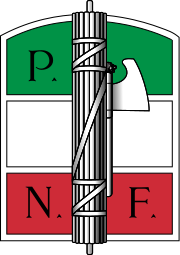
According to historian Zeev Sternhell, "most syndicalist leaders were among the founders of the fascist movement", who in later years gained key posts in Mussolini's regime.[98] Mussolini expressed great admiration for the ideas of Georges Sorel,[99] who he claimed was instrumental in birthing the core principles of Italian fascism.[100] J. L. Talmon argued that fascism billed itself "not only as an alternative, but also as the heir to socialism".[101]
La dottrina del fascismo proposed an Italy of greater living standards under a one-party fascist system than under the multi-party liberal democratic government of 1920.[102] As the leader of the National Fascist Party (PNF, Partito Nazionale Fascista), Mussolini said that democracy is "beautiful in theory; in practice, it is a fallacy" and spoke of celebrating the burial of the "putrid corpse of liberty".[102][103] In 1923, to give Deputy Mussolini control of the pluralist parliamentary government of the Kingdom of Italy (1861–1946), an economist, the Baron Giacomo Acerbo, proposed—and the Italian Parliament approved—the Acerbo Law, changing the electoral system from proportional representation to majority representation. The party who received the most votes (provided they possessed at least 25 percent of cast votes) won two-thirds of the parliament; the remaining third was proportionately shared among the other parties, thus the fascist manipulation of liberal democratic law that rendered Italy a one-party state.
In 1924, the PNF won the election with 65 percent of the votes,
Conditions precipitating fascism
Nationalist discontent
After World War I (1914–1918), despite the Kingdom of Italy (1861–1946) being a full-partner Allied Power against the Central Powers, Italian nationalism claimed Italy was cheated in the Treaty of Saint-Germain-en-Laye (1919), thus the Allies had impeded Italy's progress to becoming a "Great Power".[107] Thenceforth, the PNF successfully exploited that "slight" to Italian nationalism in presenting fascism as best-suited for governing the country by successfully claiming that democracy, socialism and liberalism were failed systems. The PNF assumed Italian government in 1922, consequent to the fascist Leader Mussolini's oratory and Blackshirt paramilitary political violence.
At the
In September 1919, the nationalist response of outraged war hero
At the same time, Mussolini and many of his revolutionary syndicalist adherents gravitated towards a form of revolutionary nationalism in an effort to "identify the 'communality' of man not with class, but with the nation".[112] According to A. James Gregor, Mussolini came to believe that "Fascism was the only form of 'socialism' appropriate to the proletarian nations of the twentieth century" while he was in the process of shifting his views from socialism to nationalism.[113] Enrico Corradini, one of the early influences on Mussolini's thought and later a member of his administration, championed the concept of proletarian nationalism, writing about Italy in 1910: "We are the proletarian people in respect to the rest of the world. Nationalism is our socialism".[114] Mussolini would come to use similar wording, for instance referring to fascist Italy during World War II as the "proletarian nations that rise up against the plutocrats".[115]
Labor unrest
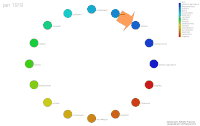
Given Italian fascism's pragmatic political amalgamations of left-wing and right-wing socio-economic policies, discontented workers and peasants proved an abundant source of popular political power, especially because of peasant opposition to socialist agricultural collectivism. Thus armed, the former socialist Benito Mussolini oratorically inspired and mobilized country and working-class people: "We declare war on socialism, not because it is socialist, but because it has opposed nationalism". Moreover, for campaign financing in the 1920–1921 period the National fascist Party also courted the industrialists and (historically feudal) landowners by appealing to their fears of left-wing socialist and Bolshevik labor politics and urban and rural strikes. The fascists promised a good business climate of cost-effective labor, wage and political stability; and the fascist Party was en route to power.
Historian Charles F. Delzell reports: "At first, the fascist Revolutionary Party was concentrated in Milan and a few other cities. They gained ground quite slowly, between 1919 and 1920; not until after the scare, brought about by the workers "occupation of the factories" in the late summer of 1920 did fascism become really widespread. The industrialists began to throw their financial support behind Mussolini after he renamed his party and retracted his former support for Lenin and the Russian Revolution. Moreover, toward the end of 1920, fascism began to spread into the countryside, bidding for the support of large landowners, particularly in the area between Bologna and Ferrara, a traditional stronghold of the Left, and scene of frequent violence. Socialist and Catholic organizers of farm hands in that region, Venezia Giulia, Tuscany, and even distant Apulia, were soon attacked by
Fascism empowered
Italy's use of daredevil elite
The Liberal government preferred fascist
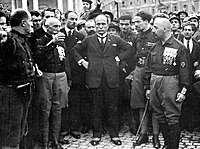
By the early 1920s, popular support for the fascist movement's fight against Bolshevism numbered some 250,000 people. In 1921, the fascists metamorphosed into the PNF and achieved political legitimacy when Mussolini was elected to the Chamber of Deputies in 1922.
To
The March on Rome became a victory parade: the fascists believed their success was revolutionary and
Economy

Until 1925, when the liberal economist
One of Prime Minister Mussolini's first acts was the 400-million-lira financing of
Given the overwhelmingly rural nature of Italian economy in the period, agriculture was vital to fascist economic policies and propaganda. To strengthen the domestic Italian production of grain, the fascist Government established in 1925
From 1926 following the Pact of the Vidoni Palace and the Syndical Laws, business and labour were organized into 12 separate associations, outlawing or integrating all others. These organizations negotiated labour contracts on behalf of all its members with the state acting as the arbitrator. The state tended to favour big industry over small industry, commerce, banking, agriculture, labour and transport even though each sector officially had equal representation.[132] Pricing, production and distribution practices were controlled by employer associations rather than individual firms and labour syndicates negotiated collective labour contracts binding all firms in the particular sector. Enforcement of contracts was difficult and the large bureaucracy delayed resolutions of labour disputes.[133]
After 1929, the fascist regime countered the
A year after the creation of the IRI, Mussolini boasted to his Chamber of Deputies: "Three-fourths of the Italian economy, industrial and agricultural, is in the hands of the state".[138][139] As Italy continued to nationalize its economy, the IRI "became the owner not only of the three most important Italian banks, which were clearly too big to fail, but also of the lion's share of the Italian industries".[140] During this period, Mussolini identified his economic policies with "state capitalism" and "state socialism", which later was described as "economic dirigisme", an economic system where the state has the power to direct economic production and allocation of resources.[141] By 1939, fascist Italy attained the highest rate of state–ownership of an economy in the world other than the Soviet Union,[142] where the Italian state "controlled over four-fifths of Italy's shipping and shipbuilding, three-quarters of its pig iron production and almost half that of steel".[143]
Relations with the Catholic Church
In the 19th century, the forces of
Not long after the Lateran Treaty was signed, Mussolini was almost "excommunicated" over his "intractable" determination to prevent the Vatican from having control over education.[147] In reply, the Pope protested Mussolini's "pagan worship of the state" and the imposition of an "exclusive oath of obedience" that obligated everyone to uphold fascism.[147] Once declaring in his youth that "religion is a species of mental disease",[148] Mussolini "wanted the appearance of being greatly favoured by the Pope" while simultaneously "subordinate to no one".[147] Mussolini's widow attested in her 1974 book that her husband was "basically irreligious until the later years of his life".[149]
Influence outside Italy
The fascist government's model was very influential beyond Italy. In the twenty-one-year
Italian fascism was copied by
Italian fascist intellectuals
- Benito Mussolini
- Massimo Bontempelli
- Giuseppe Bottai
- Enrico Corradini
- Carlo Costamagna
- Julius Evola
- Enrico Ferri
- Giovanni Gentile
- Corrado Gini
- Agostino Lanzillo
- Curzio Malaparte
- Filippo Tommaso Marinetti
- Robert Michels
- Angelo Oliviero Olivetti
- Sergio Panunzio
- Giovanni Papini
- Giuseppe Prezzolini
- Alfredo Rocco
- Edmondo Rossoni
- Margherita Sarfatti
- Ardengo Soffici
- Ugo Spirito
- Giuseppe Ungaretti
- Gioacchino Volpe
Italian fascist slogans
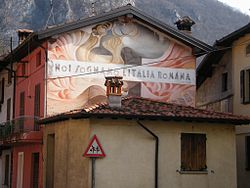
- Me ne frego ("I don't give a damn!"), the Italian fascist motto.[158]
- Libro e moschetto, fascista perfetto ("Book and musket, perfect fascist").
- Tutto nello Stato, niente al di fuori dello Stato, nulla contro lo Stato ("Everything in the State, nothing outside the State, nothing against the State").[159]
- Credere, obbedire, combattere ("Believe, Obey, Fight").[160]
- Chi si ferma è perduto ("He who hesitates is lost").
- Se avanzo, seguitemi; se indietreggio, uccidetemi; se muoio, vendicatemi ("If I advance, follow me. If I retreat, kill me. If I die, avenge me"). Borrowed from French Royalist General Henri de la Rochejaquelein.
- Viva il Duce ("Long live the Leader").
- La guerra è per l'uomo come la maternità è per la donna ("War is to man as motherhood is to woman").[161]
- Boia chi molla ("Who gives up is a rogue"); the first meaning of "boia" is "executioner, hangman", but in this context it means "scoundrel, rogue, villain, blackguard, knave, lowlife" and it can also be used as an exclamation of strong irritation or disappointment or as a pejoratively superlative adjective (e.g. tempo boia, "awful weather").[162]
- Molti nemici, molto onore ("Many enemies, much Honor").[163]
- È l'aratro che traccia il solco, ma è la spada che lo difende ("The plough cuts the furrow, but the sword defends it").
- Dux mea lux ("The Leader is my light"), Latin phrase.
- Duce, a noi ("Duce, to us").[164]
- Mussolini ha sempre ragione ("Mussolini is always right").[165]
- Vincere, e vinceremo ("To win, and we shall win!").
See also
- Definitions of fascism
- Economy of Italy under fascism
- Fascism
- Fascist architecture
- Fascist syndicalism
- Italian fascist states
- fascist state)
- Italian Social Republic (1943–1945)
- Model of masculinity under fascist Italy
- National Fascist Party
- Propaganda in Fascist Italy
- Italian fascism and racism
- Italian racial laws
- Neo-fascism
- Nazism
- Antisemitism in 21st-century Italy
- Racism in Italy
- Squadrismo
- Shōwa Statism
- Totalitarianism
References
- ^ ISBN 9780415216128
- ISBN 9780415216128
- ^ ISBN 978-1405154956
- ISBN 978-0719040047
- ^ Jim Powell, "The Economic Leadership Secrets of Benito Mussolini", Forbes, 22 February 2012
- ISBN 978-0669811414
- ISBN 978-0742531222
- ISBN 0299148742
- ^ ISBN 978-0801489211
- ^ Sestani, Armando, ed. (10 February 2012). "Il confine orientale: una terra, molti esodi" [The Eastern Border: One Land, Multiple Exoduses]. I profugi istriani, dalmati e fiumani a Lucca [The Istrian, Dalmatian and Rijeka Refugees in Lucca] (PDF) (in Italian). Instituto storico della Resistenca e dell'Età Contemporanea in Provincia di Lucca. pp. 12–13.
When dealing with such a race as Slavic—inferior and barbarian—we must not pursue the carrot, but the stick policy. We should not be afraid of new victims. The Italian border should run across the Brenner Pass, Monte Nevoso and the Dinaric Alps. I would say we can easily sacrifice 500,000 barbaric Slavs for 50,000 Italians.
[permanent dead link] - S2CID 145516332.
- S2CID 216113682.
- ^ "Minority Rights Group International – Italy – Greek-speakers" Archived 9 January 2019 at the Wayback Machine.
- ISBN 978-1137508539. Archivedfrom the original on 14 January 2019. Retrieved 13 January 2019.
- ^ Diplomatic documents relating to Italy's aggression against Greece ; the Greek White Book. American Council on Public Affairs. 1943. pp. 5–8.
- ^ ISBN 978-0521691628
- ISBN 978-0801489211
- ISBN 9780802037626
- ISBN 978-0804736152
- ^ ISBN 978-0804739467
- ISBN 978-0521737500
- ISBN 978-9612318710
- ^ Cresciani, Gianfranco (2004) Clash of civilisations Archived 6 May 2020 at the Wayback Machine, Italian Historical Society Journal, Vol. 12, No. 2, p. 4
- ISBN 0826417612.
- ^ ISBN 978-0521023665
- ISBN 0521845157.
- ^ Owen Pearson. Albania in the twentieth century: a history, Volume 3. London; New York: I.B. Taurus Publishers, 2004. p. 389. [ISBN unspecified]
- ISBN 978-1557531414
- ISBN 978-1584779018. Archivedfrom the original on 2 May 2016. Retrieved 14 August 2015.
- ^ Rodogno 2006, p. 84
- ISBN 978-0415216111
- ISBN 978-0521338356
- ^ Adda Bruemmer Bozeman. "Regional Conflicts Around Geneva: An Inquiry into the Origin", Nature, and Implications of the Neutralized Zone of Savoy and of the Customs-free Zones of Gex and Upper Savoy. p. 196.
- ^ Adda Bruemmer Bozeman. "Regional Conflicts Around Geneva: An Inquiry into the Origin", Nature, and Implications of the Neutralized Zone of Savoy and of the Customs-free Zones of Gex and Upper Savoy. Stanford, California: Stanford University Press, 1949. p. 196.
- ^ ISBN 978-0521845151
- ISBN 978-0521856027
- ^ a b John F. L. Ross. Neutrality and International Sanctions: Sweden, Switzerland, and Collective Security. ABC-CLIO, 1989. p. 91. [ISBN unspecified]
- ISBN 978-8842524229
- ISBN 978-1579583927
- ISBN 8846453646
- ^ Crespi 2004, p. 250
- ISBN 978-0521338356
- ^ ISBN 978-1841623122
- ISBN 978-1598843026
- ISBN 978-0786417100
- ISBN 978-9004164482
- ^ ISBN 978-0199327119
- ISBN 978-0714651774
- ISBN 978-0231124690
- ^ ISBN 978-9051831948
- ^ S2CID 201401541.
- ISBN 9780415290159.
- ISBN 978-0-521-84101-6.
- ^ Christopher Hibbert, Benito Mussolini (1975), p. 99
- ^ Zimmerman, p.160
- ^ Hibbert, p. 98
- ISBN 978-9004212558. Retrieved 9 January 2016.
- ^ Neocleous, Mark. Fascism. Minneapolis, Minnesota, USA: University of Minnesota Press, 1997. p. 35
- ^ "Talks with Mussolini". Little Brown and Company. 4 January 2024.
- ^ "The Manifesto of Race" (PDF). 1938. Archived from the original (PDF) on 14 April 2016. Retrieved 1 March 2019.
- ^ Hibbert, Christopher (1962). Il Duce; the Life of Benito Mussolini. Little, Brown. p. 87.
- ^ Gunther, John (1940). Inside Europe. New York: Harper & Brothers. p. 262.
- ISBN 978-0520071995
- S2CID 156952523.
- ^ Kroener, Bernhard R.; Muller, Rolf-Dieter; Umbreit, Hans (2003). Germany and the Second World War Organization and Mobilization in the German Sphere of Power. Vol. VII. New York: Oxford University Press p. 247
- ISBN 978-0-203-16489-1.
- S2CID 161818702.
- ISBN 978-1417992775. Archivedfrom the original on 25 November 2015. Retrieved 14 August 2015.
- ISBN 978-0520223639
- ISBN 978-1906033569.
- ^ a b Gunther, John (1940). Inside Europe. New York: Harper & Brothers. pp. 251–253. Archived from the original on 1 February 2019. Retrieved 18 January 2018.[ISBN unspecified]
- ^ George Sylvester Counts. Bolshevism, fascism, and capitalism: an account of the three economic systems. 3rd edition. Yale University Press, 1970. p. 96. [ISBN unspecified]
- ISBN 978-0822340157
- ISBN 978-0415080699
- ^ ISBN 978-0415080699
- ISBN 978-0415088152, p. 205.
- ^ Malagreca, Miguel (May 2006). "Lottiamo Ancora 1: Reviewing One Hundred and Fifty Years of Italian Feminism" (PDF). Journal of International Women's Studies. 7 (4). Archived (PDF) from the original on 25 December 2012. Retrieved 22 July 2012.
- ISBN 0748733868
- ISBN 978-0521831314
- ISBN 978-0415122801
- ISBN 978-0813533087
- ^ De Grand, Alexander (1976). "Women under Italian Fascism". The Historical Journal. 19 (4): 947–68.
- ^ ISBN 978-0801489211
- ^ ISBN 978-0274734382
- ISBN 978-0674784758
- ^ ISBN 978-0415116312
- ISBN 978-0199730780
- ISBN 978-1453544570
- ISBN 978-0521845151
- ^ ISBN 1589790952.
- ISBN 978-1902454085
- ISBN 978-0521023665
- ISBN 978-1611472608
- ^ ISBN 0765805936. Archivedfrom the original on 30 October 2015. Retrieved 14 August 2015.
- ^ "The Doctrine of Fascism – Benito Mussolini (1932)". WorldFutureFund.org. 8 January 2008. Archived from the original on 30 August 2017. Retrieved 21 April 2006.
- ISBN 1589790952.
- ^ ISBN 978-1857285956.
- ISBN 978-0691032894
- ISBN 978-0520044494
- ISBN 978-0691006291
- ISBN 978-0520044494
- ^ ISBN 0199133247.
- ISBN 0806523999. Archivedfrom the original on 30 November 2015. Retrieved 14 August 2015.
- ^ a b "So Long Ago". Time. 8 January 2008. Archived from the original on 24 February 2009. Retrieved 16 July 2008.
- ^ Speech of the 30th of May 1924 Archived 17 February 2010 at the Wayback Machine the last speech of Matteotti, from it.wikisource
- ISBN 978-8807808043. Retrieved 13 January 2023.
- ^ a b c d e f g "Mussolini and Fascism in Italy". FSmitha.com. 8 January 2008. Archived from the original on 23 June 2008. Retrieved 16 July 2008.
- ISBN 1842121235. Archivedfrom the original on 27 November 2015. Retrieved 14 August 2015.
- ^ Edward R. Tannenbaum. The Fascist Experience. ACLS History E-Book Project. 2008. p. 22. [ISBN unspecified]
- ^ ISBN 0748733868.
- ISBN 978-0140257007
- ISBN 0765805936
- ISBN 978-0765808554
- ISBN 978-0520044494
- ^ Mussolini's interview, "Soliloquy for 'freedom' Trimellone island", on the Italian Island of Trimelone, journalist Ivanoe Fossani, 20 March 1945, Opera Omnia, vol. 32. Interview is also known as "Testament of Benito Mussolini", or Testamento di Benito Mussolini. Also published under "Mussolini confessed to the stars", Publishing House Latinitas, Rome, 1952
- ^ Maurice Parmelle, Bolshevism, Fascism, and the Liberal-Democratic State, London; Chapman and Hill, LTD, New York: John Wiley and Son, Inc., 1935, p. 190. [ISBN unspecified]
- ^ ISBN 978-0415290180
- ^ "March on Rome". Encyclopædia Britannica. 8 January 2008.
- ^ ISBN 027596874X.
- ISBN 978-0275958640
- ISBN 978-0415249904
- ISBN 978-0472108954
- ISBN 978-0275958640. Archivedfrom the original on 24 December 2013. Retrieved 1 November 2012.
- ^ "Il manifesto dei fasci di combattimento". Archived from the original on 20 February 2014. Retrieved 2 February 2014.
- JSTOR 1852268.
- ^ "Mussolini's Italy". Appstate.edu. 8 January 2008. Archived from the original on 15 April 2008.
- ISBN 978-2913165014
- ISBN 978-2913165014
- ISBN 978-0521522779
- ISBN 978-0297765868
- ISBN 978-2913165014
- ISBN 979-1254690604
- ^ Sarti, 1968
- ISBN 0415131618.
- ISBN 0415026253.
- ^ "Anno 1925". Cronologia.it. 8 January 2008. Archived from the original on 22 July 2011. Retrieved 16 July 2008.
- ^ "The Economy in Fascist Italy". HistoryLearningSite.co.uk. 8 January 2008. Archived from the original on 15 October 2008. Retrieved 16 July 2008.
- ISBN 978-0199936694
- ^ Carl Schmidt, The Corporate State in Action: Italy under Fascism, London: Victor Gollancz Ltd., 1939, pp. 153–76. [ISBN unspecified]
- ^ Costanza A. Russo, "Bank Nationalizations of the 1930s in Italy: The IRI Formula", Theoretical Inquiries in Law, Vol. 13:407 (2012), p. 408
- ISBN 978-0521856669
- ^ Patricia Knight, Mussolini and Fascism: Questions and Analysis in History, New York: Routledge, 2003, p. 65. [ISBN unspecified]
- ISBN 978-0415102315
- ^ Lateran Treaty
- ISBN 978-0550130006
- ^ How the Vatican built a secret property empire using Mussolini's millions Archived 2 December 2016 at the Wayback Machine. Papacy used offshore tax havens to create £500m international portfolio, featuring real estate in UK, France and Switzerland. The Guardian, 21 January 2013
- ^ ISBN 0394716582
- ISBN 978-1573920674
- ISBN 978-0671812720
- ^ "Top Ten Facts About Mussolini". RonterPening.com. 27 January 2008. Archived from the original on 19 June 2008. Retrieved 16 July 2008.
- ISBN 0520226771.
- ISBN 0312231636. Archivedfrom the original on 21 November 2015. Retrieved 14 August 2015.
- ISBN 978-0252024986. Archivedfrom the original on 24 November 2015. Retrieved 14 August 2015.
- ^ "Mussolini Takes on the Mafia". AmericanMafia.com. 8 January 2008. Archived from the original on 13 February 2006. Retrieved 16 July 2008.
- ^ Alan Morris Schom, A Survey of Nazi and Pro-Nazi Groups in Switzerland: 1930–1945 Archived 26 September 2007 at the Wayback Machine for the Simon Wiesenthal Center
- ISBN 978-0415096614
- ISBN 978-0130893017
- ^ Tiso, Giovanni (22 June 2018). "A brief fascist history of I dont care". Overland. Archived from the original on 22 June 2018. Retrieved 24 October 2016.
- ^ Used by Mussolini in a speech before the Chamber of Deputies on 26 May 1927, Discorsi del 1927: Milano, Alpes, 1928, p. 157. [ISBN unspecified]
- ^ "Credere Obbedire Combattere - Vincere". Imperial War Museums. Archived from the original on 24 October 2019. Retrieved 24 October 2019.
- ISBN 978-0531064986
- ^ "Italian definition of boia" Archived 18 June 2013 at the Wayback Machine.
- ^ Squires, Nick (30 July 2018). "Italy's anti-immigration deputy PM Matteo Salvini under fire for citing Mussolini". The Telegraph. Archived from the original on 24 October 2019. Retrieved 24 October 2019.
- ^ "Europe: Bread & Circuses". Time. 13 May 1946. Archived from the original on 1 January 2012. Retrieved 10 January 2012.
- ISBN 978-1576079409– via Google Books.
Sources
- "Labor Charter" (1927–1934).
- Doctrine of Fascism, which was published as part of the entry for fascismo in the Enciclopedia Italiana, 1932.
- Sorel, Georges. Reflections on Violence.
Further reading
General
- Acemoglu, Daron; De Feo, Giuseppe; De Luca, Giacomo; Russo, Gianluca. 2022. "War, Socialism, and the Rise of Fascism: An Empirical Exploration". The Quarterly Journal of Economics
- ISBN 0674459628.
- Eatwell, Roger. 1996. Fascism: A History. New York: Allen Lane.
- Hughes, H. Stuart. 1953. The United States and Italy. Cambridge, MA: Harvard University Press.
- ISBN 978-0198716167.
- ISBN 1400040949.
- Payne, Stanley G. 1995. A History of Fascism, 1914–45. Madison, Wisc.: University of Wisconsin Press ISBN 0299148742.
- Reich, Wilhelm. 1970. The Mass Psychology of Fascism. New York: Farrar, Straus & Giroux.
- Seldes, George. 1935. Sawdust Caesar: The Untold History of Mussolini and Fascism. New York and London: Harper and Brothers.
- Smith, Denis Mack. "Mussolini, Artist in Propaganda: The Downfall of Fascism". History Today (Apr 1959) 9#4 pp. 223–232.
- ISBN 0906336007.
- Adler, Frank, and Danilo Breschi, eds. Special Issue on Italian Fascism, Telos 133 (Winter 2005).
Fascist ideology
- ISBN 0878551905.
- Fritzsche, Peter. 1990. Rehearsals for Fascism: Populism and Political Mobilization in Weimar Germany. New York: Oxford University Press. ISBN 0195057805.
- ISBN 978-0691127903.
- Griffin, Roger. 2000. "Revolution from the Right: Fascism", chapter in David Parker (ed.) Revolutions and the Revolutionary Tradition in the West 1560–1991, Routledge, London.
- Laqueur, Walter. 1966. Fascism: Past, Present, Future, New York: Oxford: Oxford University Press, 1997.
- Schapiro, J. Salwyn. 1949. Liberalism and The Challenge of Fascism, Social Forces in England and France (1815–1870). New York: McGraw-Hill.
- Laclau, Ernesto. 1977. Politics and Ideology in Marxist Theory: Capitalism, Fascism, Populism. London: NLB/Atlantic Highlands Humanities Press.
- Sternhell, Zeev with Mario Sznajder and Maia Asheri. [1989] 1994. The Birth of Fascist Ideology, From Cultural Rebellion to Political Revolution. Trans. David Maisei. Princeton, NJ: Princeton University Press.
International fascism
- Coogan, Kevin. 1999. Dreamer of the Day: Francis Parker Yockey and the Postwar Fascist International. Brooklyn, N.Y.: Autonomedia.
- Gregor, A. James. 2006. "The Search for Neofascism: The Use and Abuse of Social Science". New York: Cambridge University Press.
- Griffin, Roger. 1991. The Nature of Fascism. New York: St. Martin's Press.
- Paxton, Robert O. 2004. The Anatomy of Fascism. New York: Alfred A. Knopf.
- Weber, Eugen. [1964] 1985. Varieties of Fascism: Doctrines of Revolution in the Twentieth Century, New York: Van Nostrand Reinhold Company, contains chapters on fascist movements in different countries.
- Wallace, Henry. "The Dangers of American Fascism". The New York Times, Sunday, 9 April 1944.
- Trotsky, Leon. 1944. "Fascism, What it is and how to fight it" Pioneer Publishers (pamphlet).
External links
- "Fascist Italy and the Jews: Myth versus Reality" Archived 27 February 2017 at the Wayback Machine, an online lecture by Iael Nidam-Orvieto of Yad Vashem.
- "Fascism Part I – Understanding Fascism and Anti-Semitism".
- "The Functions of Fascism"[permanent dead link], a radio lecture by Michael Parenti.
- "The Political and Social Doctrine of Fascism" (1933), authorized translation.
- "Italian Fascism".
